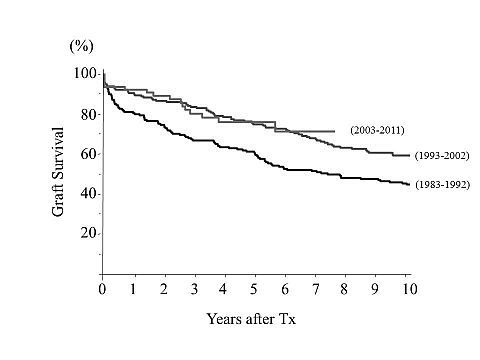Long-Term Graft Survival Retrieved from Donors after Cardiac Death Have Been Significantly Improved in These Two Decades Although the Procurement Technique Remains Unchanged during the Three Decades
Department of Urology, Fujita-Health University, Toyoake, Aichi, Japan
Department of Organ Transplant Surgery, Fujita-Health University, Toyoake, Aichi, Japan
Meeting: 2013 American Transplant Congress
Abstract number: C1273
Introduction: Since 1979, 535 kidneys were retrieved from 270 DCD donors at our center, using in situ regional cooling technique. In this study, the posttransplant outcomes as well as long-term survivals of renal grafts from DCD were retrospectively compared between the decades; the first decade (FD): 1983–1992 (n=176), the second decade (SD): 1993–2002 (n=176) and the third decade (TD), 2003– 2012 (n=91).
Methods: All the kidneys were retrieved using the identical technique. All the patients were treated with immunotherapy consisting of CNI, steroid and other immunosuppressant.
Results; Among FD, SD and TD, there is no difference in the donor age, however, the recipient age and total ischemic time were significantly different; 36.9 (FD), 43.7 (SD) and 47.6 years (TD) (p<0.01), and 579, 1027 and 800 minutes (p<0.01), respectively. The incidence of primary non-function and delayed graft function were not different among three decades. Contrarily, the incidence of immediate function were higher in SD and TD (17 vs 10 and 9%), posttransplant dialysis period were significantly shorter in TD (11 and 12 vs 8 days, p<0.05) and the nadir s-Cr was significantly lower in SD and TD (1.6 vs 1.4 and 1.3 mg/dl, p<0.05). There was no difference in patient survival among the three decades. However, the long-term graft survival in SD and TD was significantly improved comparing with that in FD (p<0.001).

Conclusion: The renal grafts retrieved from DCD using in situ regional cooling technique provided an excellent graft function and good long-term graft survival, and the posttransplant outcome was improved in SD and TD comparing with that in FD, although the age of recipients was significantly older and waiting time have become longer. The reason may be due to the improvement of posttransplant patient managements including immunotherapy, since all the kidneys were retrieved using the identical technique.
To cite this abstract in AMA style:
Kusaka M, Kubota Y, Fukami N, Takenaka M, Sasaki H, Shiroki R, Kenmochi T, Hoshinaga K. Long-Term Graft Survival Retrieved from Donors after Cardiac Death Have Been Significantly Improved in These Two Decades Although the Procurement Technique Remains Unchanged during the Three Decades [abstract]. Am J Transplant. 2013; 13 (suppl 5). https://atcmeetingabstracts.com/abstract/long-term-graft-survival-retrieved-from-donors-after-cardiac-death-have-been-significantly-improved-in-these-two-decades-although-the-procurement-technique-remains-unchanged-during-the-three-decades/. Accessed December 17, 2025.« Back to 2013 American Transplant Congress
